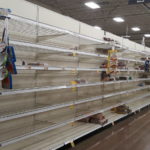
Despite some signs that grocery shopping may be getting closer to normal, one recent survey showed that many of us don’t expect our grocery shopping routine to return to the way it used to be anytime soon. Now, another survey indicates that this new normal could be hazardous to our wallets, our waistlines and our mental health.
According to the market insights firm C+R Research, nearly half of us are spending more on groceries, and buying and eating more unhealthy foods. And if that isn’t stressful enough, many of us have witnessed “grocery rage” in stores – or even been a party to it.
45% of survey respondents said they’re spending more money on groceries these days, with the average cost of a single grocery trip rising from $159 to $184. That’s partly because we’ve been stocking up and buying more than we usually would during one grocery trip. And it’s partly because many stores are offering fewer money-saving promotions.
When looking for a particular item, “brand loyalty has taken a backseat,” C+R found. “Overall, 76% said they do not go out of their way to find their favorite brands.” And 52% said they will buy whatever is available rather than looking for the best deal – largely because they have little choice. After all, if you need toilet paper and can’t find your usual brand, or there’s no toilet paper on sale, are you really going to refuse to buy it until you can get a good deal on your favorite brand? 88% of shoppers said they can’t find certain items they normally buy – so most of us have had to make compromises at times, buying a needed item no matter the brand and no matter the price.
And what, exactly, are we buying? Household supplies like toilet paper and disinfectant products flew off the shelves in the early days of the pandemic, of course. But we still have to eat. And whether it’s due to supply issues or the desire to treat ourselves, we’re not necessarily eating healthy. 47% of shoppers said they’re eating more processed foods, with 36% buying less produce and 26% buying less meat.
An increase in stress eating could be because grocery shopping itself has become stressful. “Not only has the COVID-19 pandemic impacted shopping habits, but it also has caused other psychological effects on consumers,” C+R said. 60% of shoppers are fearful to shop at a grocery store, or “feel a sense of panic or anxiety” when grocery shopping. And 45% disinfect their groceries after bringing them home.
Shoppers also feel wronged if their stores or fellow shoppers don’t play fair – 50% say they’ve witnessed price gouging in stores, and 89% agree that stores should place limits on some items to thwart shelf-clearers. Overall, 73% are making fewer trips to physical grocery stores, with more shoppers opting for grocery delivery services or just skipping their usual shopping trips to use whatever they already have at home instead.
And all this stress can lead to “grocery rage.” 19% of shoppers have witnessed an argument in a store, while 11% have witnessed a physical altercation. And 8% admit that they themselves have gotten into an argument or a physical altercation.
Yikes. It’s getting ugly out there. But C+R is urging calm. “It is important for both consumers and businesses to do all that they can together in order to combat the pandemic,” its report concludes. So hopefully you still can get what you need without breaking the bank, and without sacrificing your health or your sanity. Just do your best not to throw any punches at fellow shoppers in the process.
Image source: Kroger
















As long as those things don’t conflict. For instance, while limits may be needed on a few items where supply has been hard to come by, putting too many limits will only harm the idea of trying to keep people from going to the store too often, since they’ll need to return more often if they can’t get enough of things in one visit.
Also, you’d think stores could find some way to know (particularly those with card type programs that record what people buy) where there may be cases that people need to buy more (someone with a large family, for instance).
In terms of the pricing, some may be store raising them, but many may be higher costs from the manufacturers that stores are just passing along, and probably at least a few cases where people are just seeing normal prices but thinking they are high as they usually buy the items on sale or a different brand that is not available at the moment.